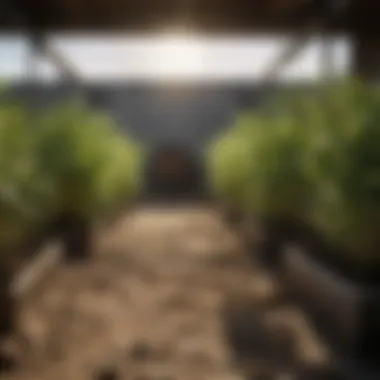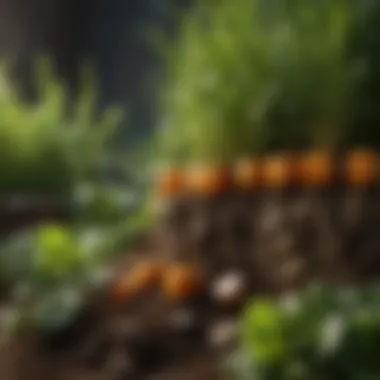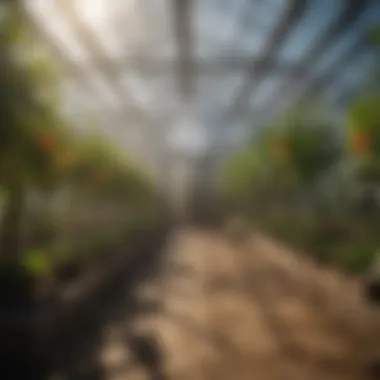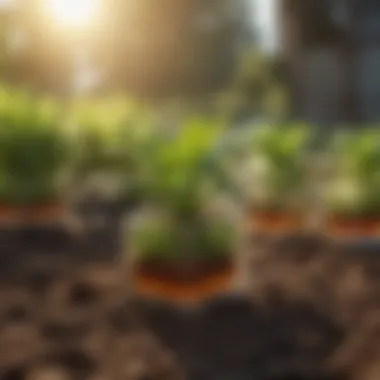An In-Depth Guide to Planting Cubes in Agriculture


Intro
Planting cubes are an innovative approach to agriculture, aimed primarily at enhancing crop growth while promoting sustainability. These cubes act as a medium for plants, providing essential nutrients and support for root development. Given their unique structure, they enable efficient use of space and resources, which is particularly vital in modern agricultural practices.
With increasing pressure on global food production, understanding the principles and applications of planting cubes can significantly influence farming outcomes. The next sections explore latest trends and techniques, emphasizing their relevance to farmers and agricultural enthusiasts.
Latest Trends in Agriculture
Overview of Current Trends
The agricultural landscape is rapidly evolving, driven by technological advancements and changing environmental policies. One major trend is the integration of planting cubes within hydroponics and vertical farming systems. These methods utilize less land and water compared to traditional farming, making them essential for urban agriculture.
Farmers are increasingly adopting smart farming tools, such as drones and IoT sensors, which optimize resource allocation and monitor crop health. Such technologies offer real-time data, ensuring that planting cubes are used effectively to maximize yield.
Impact of Technology on Farming Practices
Technological innovation plays a pivotal role in modern agriculture. For instance, automated irrigation systems can be synchronized with planting cubes to provide tailored water and nutrient delivery, promoting optimal growth. Furthermore, software solutions allow farmers to analyze soil conditions and plan the cultivation of various crops accordingly.
"Technology bridges the gap between agricultural potential and operational efficiency, making it possible to achieve sustainability goals while ensuring economic viability."
Sustainable Practices: Towards a Greener Future
Importance of Sustainability in Agriculture
Sustainability is no longer just a buzzword; it is a necessity in agriculture. Sustainable practices help in preserving ecosystems while also enabling effective food production. Planting cubes contribute to these practices by minimizing waste and optimizing input use, leading to a lower environmental footprint.
Methods for Sustainable Farming
To achieve sustainable outcomes, incorporate the following methods alongside planting cubes:
- Crop rotation: This practice prevents soil depletion by alternating different crops, enhancing nutrient availability.
- Composting: Utilizing organic waste enriches soil health, benefiting both traditional and cube-supported crops.
- Integrated pest management: A holistic approach to pest control that reduces dependency on chemical pesticides, enhancing both plant health and biodiversity.
Gardening Techniques and Tips
Essential Gardening Tools and Equipment
For those looking to implement planting cubes effectively, having the right tools is critical. Consider the following:
- Gloves and hand tools: Essential for managing planting and maintenance tasks.
- Watering cans or irrigation hoses: Vital for efficient watering of planting cubes.
- Soil testing kits: Ensure that nutrient levels are appropriate for the crops being cultivated.
Seasonal Gardening Practices
Understanding seasonal variations is crucial for the successful use of planting cubes. Follow this simple guideline:
- Spring: Begin planting with seeds that thrive in warmer weather.
- Summer: Monitor moisture levels closely as cubes can dry out quickly in higher temperatures.
- Autumn: Prepare for harvest; ensure roots are developing adequately in the cubes.
- Winter: Consider using indoor gardening techniques to make use of remaining cubes.
By exploring these aspects, farmers and enthusiasts can better appreciate the role of planting cubes in contemporary agriculture.
Understanding Planting Cubes
Planting cubes are an innovative approach in modern agriculture, fundamentally altering how crops are cultivated. Understanding planting cubes is crucial, especially for farmers and agriculture enthusiasts seeking to improve their practices. These cubes help in optimizing space, enhancing growth rates, and promoting sustainable farming methods.
Definition and Composition
Planting cubes refer to small, often pre-formed blocks made from various materials to support plant roots as they grow. These cubes can be composed of organic, inorganic, or biodegradable materials. The composition affects water retention, nutrient release, and the overall health of the plant.
- Organic Cubes: Typically made from peat moss, coconut coir, or compost. They offer a natural environment for seed germination and root growth.
- Inorganic Cubes: Often made from materials like rock wool or polyurethane foam. These are superior in providing structural support but may lack nutrients essential for plant health.
- Biodegradable Options: Made from starch or other plant-based materials that decompose over time, they provide nutrients as they break down.


The diverse composition of planting cubes allows farmers to select the best option for their specific crops and environmental conditions.
Historical Context
Historically, agriculture has relied heavily on traditional methods of planting, such as tilling the soil and using seed beds. However, this approach has limitations, including soil erosion and decreased soil fertility over time.
The introduction of planting cubes began to address these challenges. In the late 20th century, researchers and agricultural innovators began exploring alternatives to conventional seed planting. The idea was to create an environment that allows for better root development while promoting efficient use of resources such as water and nutrients.
As technology improved, so did the design and functionality of planting cubes, enabling their wider adoption in various agricultural practices. Today, they are utilized in multiple settings, from small urban farms to large-scale agricultural operations. This evolution reflects a broader trend towards sustainable agriculture, indicating a significant shift in how food is produced around the globe.
Types of Planting Cubes
Understanding the different Types of Planting Cubes is crucial for farmers and enthusiasts who are looking to enhance their agricultural practices. Varieties of planting cubes, whether organic, inorganic, or biodegradable, each have unique benefits and limitations. The selection of a specific type may affect not only the efficiency of the planting process but also the sustainability of farming operations. This understanding leads to informed decisions tailored to the specific needs of crops and the goals of the grower.
Organic Cubes
Organic cubes are primarily made from natural materials. These might include peat moss, coconut coir, or compost. One of the main benefits of organic cubes is that they enrich the soil as they decompose. They provide essential nutrients that promote healthy plant growth. Additionally, organic cubes support biodiversity, fostering a more natural ecosystem in the garden.
However, a few challenges exist. Organic cubes can be more expensive than their inorganic counterparts. They also require careful management to prevent mold or pests. Farmers must monitor these cubes closely to ensure they maintain optimal conditions for growth.
Inorganic Cubes
In contrast to organic options, inorganic cubes are typically made from synthetic materials like expanded polystyrene or rock wool. These materials offer consistent quality and performance. Inorganic cubes often provide superior aeration and drainage, which can lead to faster root establishment for the plants.
Yet, the use of inorganic cubes comes with its disadvantages. They do not biodegrade and can contribute to environmental waste. Furthermore, they might not provide the same nutrient profile as organic cubes, potentially necessitating additional fertilizers.
With increasingly stricter regulations on environmental impact, farmers should be cautious when opting for inorganic cubes. Not all crops may thrive in these conditions, so compatibility should be assessed before use.
Biodegradable Options
Biodegradable cubes present a middle ground between organic and inorganic solutions. They are designed to decompose over time, returning nutrients to the soil while offering the stability needed for initial plant growth. Materials such as biodegradable plastics or other renewable resources can be used.
The key advantage here is sustainability. These cubes allow for efficient resource use without the long-term waste associated with traditional inorganic options. They also do not require disposal after their intended use, aligning well with eco-conscious farming practices.
However, users must consider their longevity. The rate of decomposition can vary widely based on environmental conditions, and inadequate management might lead to premature degradation. Therefore, careful selection and monitoring are essential.
"Choosing the right type of planting cube is a significant decision that impacts crop success and sustainability."
In summary, each type of planting cube comes with its distinct set of advantages and considerations. The decision should align with the crop requirements, budget constraints, and environmental impact goals. By understanding these elements, agriculture practitioners can make better-informed decisions regarding their planting strategies.
Benefits of Using Planting Cubes
The integration of planting cubes in agricultural practice presents numerous advantages, which warrant attention and consideration. These benefits can significantly affect the efficiency of crop growth and overall yield. Understanding these facets is essential for farmers and agricultural enthusiasts aiming to enhance their farming techniques.
Enhanced Root Development
One primary benefit of planting cubes is their potential to significantly enhance root development. With their structured composition, planting cubes provide a stable environment supportive to root systems. This structure creates an ideal space for roots to grow, allowing them to spread more effectively. In traditional soil planting, the root growth can be compromised due to compact soil, which hinders nutrient absorption and water uptake.
The use of planting cubes mitigates this issue. They encourage deeper and healthier roots, which boost the plant’s stability and resilience. Roots developed in cubes tend to exhibit consistent growth patterns and improve nutrient and moisture absorption, leading to stronger plants overall. The initial stages of plant growth greatly benefit from this, producing healthier crops faster.
Improved Soil Aeration
Another key advantage is the enhanced soil aeration that planting cubes provide. Good soil aeration is vital for root respiration, a process that enables plants to thrive. In conventional soil planting, compaction can limit air pockets that roots require to breathe, leading to poor growth. However, planting cubes, by their design, allow for adequate air circulation.
This benefit ensures that roots access oxygen more readily. Improved airflow also promotes beneficial microbial activity in the soil. Such microorganisms are essential for breaking down organic materials and making nutrients available to plants. A well-aerated environment not only supports plant health but also contributes to overall soil quality.
Water Retention Characteristics
The third crucial benefit of planting cubes lies in their ability to retain water efficiently. Water retention is particularly important in agriculture, as it directly affects plant health and growth. Many planting cubes are designed with materials that optimize water retention while preventing waterlogging. This aspect ensures that crops receive the necessary hydration without the risks associated with over-saturation.


The precise water balance achieved through planting cubes allows for a more consistent growth environment. This capability reduces the frequency of watering, which is a significant advantage for farmers aiming to conserve water resources. Proper water retention also minimizes stress on the plants during dry spells, leading to improved crop yield.
The use of planting cubes results in stronger root systems, better aeration, and optimal water management, all of which contribute to successful crop production.
In summary, the benefits of using planting cubes in agriculture are multifaceted. Enhanced root development, improved soil aeration, and superior water retention create a conducive environment for crops to thrive. By leveraging these advantages, farmers can improve their agricultural practices and achieve better results.
Applying Planting Cubes in Agricultural Practices
The utilization of planting cubes in agricultural practices represents a significant advancement in how crops are managed and cultivated. Integrating these cubes into farming sets a framework for both efficiency and enhanced productivity. The specific elements within this topic showcase the careful preparation, strategic planting techniques, and ongoing maintenance that can substantially improve the success rates of crop yield.
Preparation of Cubes
Before planting, preparing the planting cubes is crucial. This involves ensuring the cubes are conducive to healthy crop growth. To start, one should assess the nutritional content of the cubes. Organic options like those using peat moss often require specific treatments to maximize nutrient availability. Meanwhile, inorganic cubes might be pre-treated to control moisture retention levels. Necessary steps in preparation include:
- Soaking: Soaking cubes before planting helps to enhance their ability to retain water and nutrients.
- Nutrient Addition: If cubes are nutrient-poor, integrating fertilizers or organic matter can help enrich them. This can boost the growth potential of seedlings once planted.
- Temperature Control: Allowing cubes to reach an optimal planting temperature can reduce transplant shock, benefiting seedlings that are sensitive to drastic shifts in their environment.
The preparation phase can not only dictate the health of young plants but can also set the tone for the entire growing season.
Planting Techniques
Once the planting cubes are prepared, the next step involves adopting effective planting techniques. A few important considerations include:
- Depth of Planting: Each cube type often has recommendations on how deep plants should be inserted. Following these guidelines can prevent root damage and facilitate stronger root establishment.
- Spacing: Proper spacing between cubes is necessary to allow air flow and nutrient uptake. This reduces competition among plants, thus enabling better growth and yield.
- Timing: Aligning planting times with local climate conditions and crop cycles is key. Early or late planting can result in yield losses, making it crucial to plan accordingly.
Employing the right techniques can significantly enhance root development and overall plant health, ultimately influencing the success of crop production.
Maintenance and Monitoring
Ongoing maintenance and monitoring play a vital role in the lifecycle of plants grown in planting cubes. Farmers must stay vigilant to ensure optimal conditions. Key maintenance activities include:
- Watering Regimen: Plants require a consistent watering schedule. Monitoring moisture levels within cubes is essential to avoid both under-watering and over-watering.
- Nutrient Management: Regularly checking the nutrient levels and replenishing them as needed depends on the crop type and stage of growth.
- Pest and Disease Control: Regular monitoring for pests or diseases is vital. Early detection enables prompt intervention, thereby reducing damage.
Maintaining vigilance in these areas ensures that plants mature properly and reach their yield potential.
Challenges and Considerations
Understanding the challenges and considerations of planting cubes is essential for those in agriculture. This section delves into critical factors such as cost implications, environmental impacts, and compatibility with various crop types. Each of these areas impacts not only the immediate success of using planting cubes, but also long-term sustainability practices in agriculture.
Cost Implications
When evaluating planting cubes, one must consider the financial aspects. The initial investment for planting cubes can vary significantly based on materials and technology. Organic cubes may come at a premium, while inorganic options might be more budget-friendly.
A farmer might find that investing in high-quality biodegradable cubes could lead to savings in soil amendments and less need for chemical fertilizers. On the contrary, cheaper options can lead to increased long-term costs due to lower durability or insufficient plant support. It is essential to perform a cost-benefit analysis to evaluate which type of cube maximizes yield without leading to excessive spending.
Factors to consider include:
- Initial Cost: Compare different brands and materials.
- Maintenance Cost: Evaluate the cost of maintenance over time.
- Yield Returns: Estimation of crop yield improvement if using cubes.
Environmental Impacts
Environmental considerations play a vital role in the decision-making process of using planting cubes. The materials involved in the production of planting cubes can either benefit or harm the ecosystem. For instance, traditional inorganic cubes may contribute to increased carbon footprints during their production.
In contrast, choosing biodegradable options can significantly reduce environmental damage. These materials break down naturally, thus improving soil health over time. However, the biodegradability must be assessed relative to the local environment and crop needs.
Considerations for assessing environmental impacts include:
- Material sourcing: Does it impact local ecosystems?
- Lifecycle assessment: How do the cubes perform throughout their usage and disposal?
- Soil health: Evaluate how the cubes positively or negatively affect soil biology.
"The selection of planting cubes must align with sustainable practices to minimize environmental harm."


Compatibility with Different Crop Types
Not all planting cubes are suitable for every crop type. Compatibility is a significant consideration as using the wrong cube can lead to poor plant development. Some cubes are designed specifically for root systems of certain plants, while others may be too dense or too lose for others.
Farmers must research and understand the crop’s root structure and nutrient needs. Different crops require varying degrees of aeration, moisture retention, and nutrient release, which these cubes can provide.
Points to consider include:
- Root Structure: Assess the root depth and density of the crop.
- Moisture Needs: Analyze the moisture requirements of the target plant.
- Nutrient Availability: Ensure the cube can support the nutrient uptake of the selected crops.
Recognizing these challenges helps guide farmers toward informed choices in using planting cubes. Each of these considerations ultimately shapes agricultural productivity and sustainability.
Innovations in Planting Cube Technology
The evolution of planting cubes has seen remarkable innovations that enhance their functionality in agriculture. As the farming sector moves towards advanced technologies, these innovations play a crucial role in improving crop yield, optimizing resource usage, and promoting sustainability. Embracing new methodologies can transform conventional agricultural practices and ensure food security in changing climates.
Smart Cubes with Sensors
One significant innovation in planting cubes is the advent of smart cubes equipped with sensors. These technological advancements allow for real-time data collection related to soil moisture, temperature, and nutrient levels. This information is invaluable for farmers, as it enables them to make informed decisions regarding irrigation and fertilization. Smart cubes not only help in optimizing resource use but also reduce waste, ensuring that crops receive the precise amount of water and nutrients they need. Moreover, they can integrate with mobile applications or farm management systems, allowing for easy monitoring and analysis of crop health.
Integration with Hydroponics
Another area of innovation is the integration of planting cubes with hydroponic systems. Hydroponics allows crops to be grown without soil, as plants receive nutrients directly from a water solution. By using planting cubes in hydroponic setups, farmers can ensure stable support for plant roots while maximizing space efficiency. This method reduces the risk of soil-borne diseases and pest infestations, which are common in traditional farming. Additionally, hydroponics enables year-round crop production, irrespective of external climate factors. The combination of planting cubes and hydroponics serves as a forward-looking approach in urban farming, where space and resources are limited.
Sustainable Materials
Sustainability remains a core consideration in agricultural innovation. The development of planting cubes using sustainable materials has gained traction. For instance, some cubes are now made from recycled plastics or biodegradable substances. This reduces the environmental footprint associated with traditional plastic cubes. Sustainable materials not only decrease waste but can also enhance soil health when decomposed. By choosing eco-friendly options, farmers contribute to a more sustainable agricultural practice, aligning with broader environmental goals.
"Innovations in planting cube technology not only benefit the efficiency of farming practices but also contribute to a sustainable future in agriculture."
The importance of these innovations cannot be overstated. They represent a shift towards modern farming techniques that embrace technology for improved outcomes. As farmers explore these options, the potential for enhanced productivity and sustainability becomes evident, confirming that innovations in planting cube technology are vital for the future of agriculture.
Case Studies in Successful Implementations
Case studies serve as a vital link between theory and practice in the usage of planting cubes. By examining real-world applications, they demonstrate the effectiveness of these tools in enhancing agricultural practices. The insights gained from these examples highlight key benefits, potential challenges, and best practices that can guide both novice and experienced farmers. Moreover, they underscore how adaptable planting cubes can be, offering innovative solutions to various farming methods.
Agricultural Cooperatives and Planting Cubes
Agricultural cooperatives have become champions of sustainable practices. Using planting cubes in their operations showcases how collaboration can lead to improved crop yields. For example, a cooperative may implement organic planting cubes to promote biodiversity while supporting local ecosystems. These cubes enhance soil quality and foster a healthier environment for crops. Cooperatives can also share resources and knowledge, making it easier to adopt and optimize the use of planting cubes. By pooling their experiences, these groups can innovate faster and reduce individual costs, bringing down the financial barrier for small-scale farmers.
Urban Farming Projects Using Cubes
The rise of urban farming projects has brought fresh attention to planting cubes. In densely populated cities, space is limited, but planting cubes provide an efficient solution for growing food. Initiatives in cities like New York and Tokyo demonstrate that vertical farms using these cubes can produce crops in small areas while improving local food security. The integration of planting cubes in urban settings also allows for better control of growing conditions, which can be tailored for specific plants. This adaptability is essential for maximizing yield in restricted environments, proving that planting cubes can significantly impact urban sustainability.
Research Institutions and Trials
Research institutions play a crucial role in advancing the understanding of planting cubes. Trials conducted by universities and agricultural research centers provide empirical data that validates the benefits of using these tools in diverse farming conditions. These studies often focus on critical factors like root growth and nutrient absorption, assessing how different types of planting cubes perform over time. The findings not only guide farmers in choosing the right products but also contribute to broader agricultural practices. Engaging with research helps farmers stay ahead in the competitive landscape, leveraging accurate information to make informed decisions about planting cube usage.
Future Directions in Planting Cube Usage
The future of planting cubes in agriculture presents significant opportunities for enhancing crop production efficiency and sustainability. As the world faces increasing food demand due to population growth and resource constraints, innovative solutions like planting cubes are gaining attention. This section explores predictive trends in crop production and the role of planting cubes in sustainable agriculture, highlighting their importance in modern farming practices.
Predictive Trends in Crop Production
The agricultural sector is rapidly evolving, driven by technology and the need for increased yields. Planting cubes play a crucial role in this transformation. Predictive analytics is becoming more prevalent, allowing farmers to make informed decisions based on data. This can include weather trends, soil composition, and plant growth metrics.
- Precision Farming: Advancements in precision farming enable the analysis of where and how planting cubes can be optimally used. Mapping crop requirements and environmental variables helps in strategically placing these cubes.
- Data-Driven Insights: Collecting data on growing conditions and plant performance within cubes can help predict yields more accurately. Tools such as satellite imagery and drones are emerging to assist in monitoring crops in real-time.
- Resource Efficiency: By integrating predictive technologies, farmers can minimize waste. For example, determining the exact amount of nutrients or water each cube needs can lead to more efficient resource use.
Role in Sustainable Agriculture
Sustainable agriculture is more important than ever as it focuses on methods that do not compromise the ability of future generations to meet their needs. Planting cubes directly contribute to this goal in various ways.
- Reducing Soil Degradation: Unlike traditional soil-based farming, planting cubes reduce soil disturbance. This practice helps preserve soil health, preventing erosion and promoting biodiversity.
- Water Conservation: Using planting cubes allows for precise irrigation techniques, which can significantly reduce water usage. This is crucial in areas facing water scarcity and contributes to overall sustainability.
- Minimizing Chemical Inputs: Many planting cubes are made from organic or biodegradable materials. Their use can limit the need for chemical fertilizers and pesticides, which can harm the surrounding environment.
"The adoption of planting cubes can lead to a paradigm shift in how we approach farming, yielding more with less while maintaining ecological balance."







